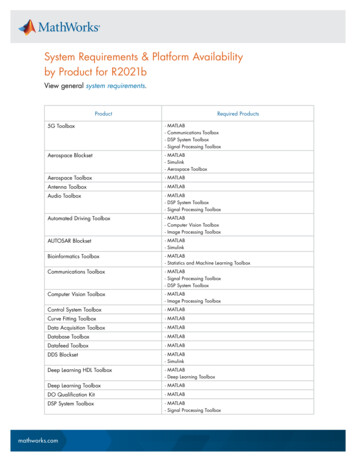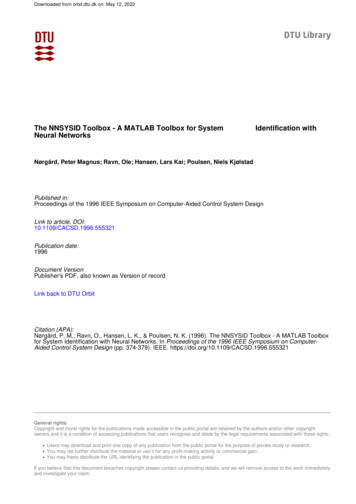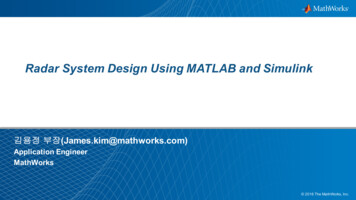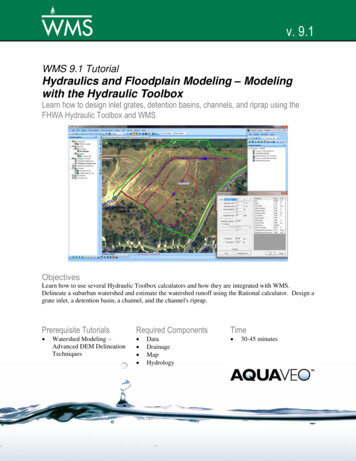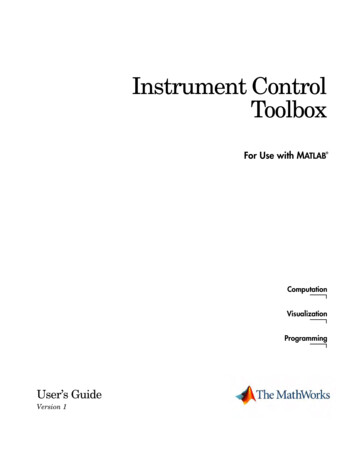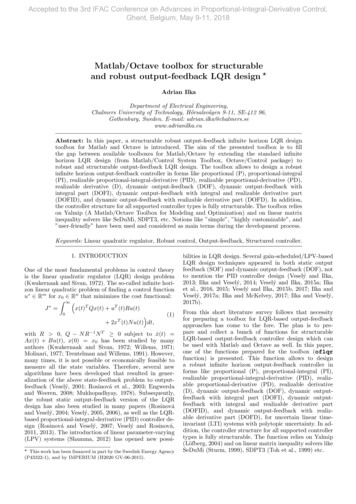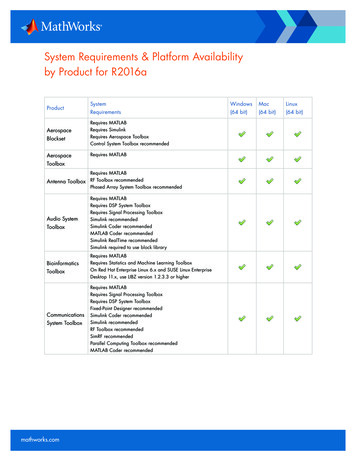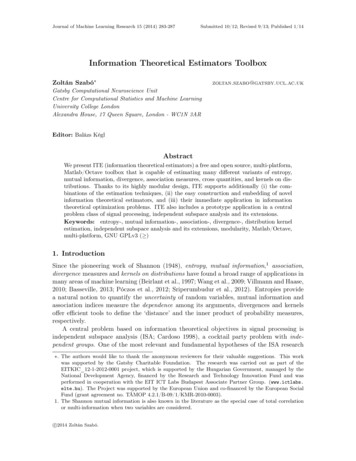
Transcription
Journal of Machine Learning Research 15 (2014) 283-287Submitted 10/12; Revised 9/13; Published 1/14Information Theoretical Estimators ToolboxZoltán Szabó zoltan.szabo@gatsby.ucl.ac.ukGatsby Computational Neuroscience UnitCentre for Computational Statistics and Machine LearningUniversity College LondonAlexandra House, 17 Queen Square, London - WC1N 3AREditor: Balázs KéglAbstractWe present ITE (information theoretical estimators) a free and open source, multi-platform,Matlab/Octave toolbox that is capable of estimating many different variants of entropy,mutual information, divergence, association measures, cross quantities, and kernels on distributions. Thanks to its highly modular design, ITE supports additionally (i) the combinations of the estimation techniques, (ii) the easy construction and embedding of novelinformation theoretical estimators, and (iii) their immediate application in informationtheoretical optimization problems. ITE also includes a prototype application in a centralproblem class of signal processing, independent subspace analysis and its extensions.Keywords: entropy-, mutual information-, association-, divergence-, distribution kernelestimation, independent subspace analysis and its extensions, modularity, Matlab/Octave,multi-platform, GNU GPLv3 ( )1. IntroductionSince the pioneering work of Shannon (1948), entropy, mutual information,1 association,divergence measures and kernels on distributions have found a broad range of applications inmany areas of machine learning (Beirlant et al., 1997; Wang et al., 2009; Villmann and Haase,2010; Basseville, 2013; Póczos et al., 2012; Sriperumbudur et al., 2012). Entropies providea natural notion to quantify the uncertainty of random variables, mutual information andassociation indices measure the dependence among its arguments, divergences and kernelsoffer efficient tools to define the ‘distance’ and the inner product of probability measures,respectively.A central problem based on information theoretical objectives in signal processing isindependent subspace analysis (ISA; Cardoso 1998), a cocktail party problem with independent groups. One of the most relevant and fundamental hypotheses of the ISA research . The authors would like to thank the anonymous reviewers for their valuable suggestions. This workwas supported by the Gatsby Charitable Foundation. The research was carried out as part of theEITKIC 12-1-2012-0001 project, which is supported by the Hungarian Government, managed by theNational Development Agency, financed by the Research and Technology Innovation Fund and wasperformed in cooperation with the EIT ICT Labs Budapest Associate Partner Group. (www.ictlabs.elte.hu). The Project was supported by the European Union and co-financed by the European SocialFund (grant agreement no. TÁMOP 4.2.1/B-09/1/KMR-2010-0003).1. The Shannon mutual information is also known in the literature as the special case of total correlationor multi-information when two variables are considered.c 2014 Zoltán Szabó.
Zoltán Szabóis the ISA separation principle (Cardoso, 1998): the ISA task can be solved by ICA (ISAwith one-dimensional sources, Hyvärinen et al. 2001; Cichocki and Amari 2002; Choi et al.2005) followed by clustering of the ICA elements. This principle (i) forms the basis of thestate-of-the-art ISA algorithms, (ii) can be used to design algorithms that scale well and efficiently estimate the dimensions of the hidden sources, (iii) has been recently proved (Szabóet al., 2007) and (iv) can be extended to different linear-, controlled-, post nonlinear-, complex valued-, partially observed systems, as well as to systems with nonparametric sourcedynamics. For a recent review on the topic and ISA applications, see Szabó et al. (2012).Although there exist many exciting applications of information theoretical measures, tothe best of our knowledge, available packages in this domain focus on (i) discrete variables,or (ii) quite specialized applications/information theoretical estimation methods. Our goalis to fill this serious gap by coming up with a (i) highly modular, (ii) free and open source,(iii) multi-platform toolbox, the ITE (information theoretical estimators) package, whichfocuses on continuous variables and1. is capable of estimating many different kind of entropy, mutual information, association, divergence measures, distribution kernels based on nonparametric methods.22. offers a simple and unified framework to (i) easily construct new estimators fromexisting ones or from scratch, and (ii) transparently use the obtained estimators ininformation theoretical optimization problems,3. with a prototype application in ISA and its extensions.2. Library OverviewBelow we provide a brief overview of the ITE package:Information Theoretical Measures: The ITE toolbox is capable of estimating numerousimportant information theoretical quantities includingEntropy: Shannon-, Rényi-, Tsallis-, complex-, Φ-, Sharma-Mittal entropy,Mutual information: generalized variance, kernel canonical correlation analysis, kernel generalized variance, Hilbert-Schmidt independence criterion, Shannon-, L2 -,Rényi-, Tsallis-, Cauchy-Schwartz quadratic-, Euclidean distance based quadratic-,complex-, χ2 mutual information; copula-based kernel dependency, multivariateversion of Hoeffding’s Φ, Schweizer-Wolff’s σ and κ, distance covariance and correlation, approximate correntropy independence measure,Divergence: Kullback-Leibler-, L2 -, Rényi-, Tsallis-, Cauchy-Schwartz-, Euclideandistance based-, Jensen-Shannon-, Jensen-Rényi-, Jensen-Tsallis-, K-, L-, Pearsonχ2 -, f-divergences; Hellinger-, Bhattacharyya-, energy-, (non-)symmetric Bregman, J-distance; maximum mean discrepancy,Association measure: multivariate (conditional) extensions of Spearman’s ρ, (centered) correntropy, correntropy induced metric, correntropy coefficient, centeredcorrentropy induced metric, multivariate extension of Blomqvist’s β, lower andupper tail dependence via conditional Spearman’s ρ,Cross quantity: cross-entropy,2. It is highly advantageous to apply nonparametric approaches: the ‘opposite’ plug-in type methods—estimating the underlying densities—scale poorly as the dimension is increasing.284
Information Theoretical Estimators (ITE) ToolboxDistribution kernel: expected-, Bhattacharyya-, probability product-, (exponentiated) Jensen-Shannon-, (exponentiated) Jensen-Tsallis-, exponentiated JensenRényi kernel.Independent Process Analysis (IPA): ITE offers solution methods for independent subspace analysis (ISA) and its extensions to different linear-, controlled-, post nonlinear-,complex valued-, partially observed systems, as well as to systems with nonparametricsource dynamics; combinations are also possible. The solutions are based on the ISAseparation principle and its generalizations (Szabó et al., 2012).Quick Tests: Beyond IPA, ITE provides quick tests to study the efficiency of the estimators. These tests cover (i) analytical value vs. estimation, (ii) positive semi-definitenessof Gram matrices defined by distribution kernels and (iii) image registration problems.Modularity: The core idea behind the design of ITE is modularity. The modularity isbased on the following four pillars:1. The estimation of many information theoretical quantities can be reduced tok-nearest neighbor-, minimum spanning tree computation, random projection,ensemble technique, copula estimation, kernel methods.2. The ISA separation principle and its extensions make it possible to decompose thesolutions of the IPA problem family to ICA, clustering, ISA, AR (autoregressive)-,ARX- (AR with exogenous input) and mAR (AR with missing values) identification, gaussianization and nonparametric regression subtasks.3. Information theoretical identities can relate numerous entropy, mutual information, association, cross- and divergence measures, distribution kernels (Cover andThomas, 1991).4. ISA can be formulated via information theoretical objectives (Szabó et al., 2007):1JI (P) I y , . . . , yJsumH (P) MXM ,JIrecursive (P) H (ym ) ,X I ym , ym 1 , ., yM ,m 1MXJsum-I (P) m 1JIpairwise (P) M 1X I y1m , ., ydMm ,m 1dm1 dm2MI (ym1 , ym2 ) , JIpairwise1d (P) m1 6 m2X XX I yim1 1 , yim2 2 ,m1 6 m2 i1 1 i2 1where the minimizations are w.r.t. the optimal clustering (P) of the ICA elements.Dedicated Subtask Solvers, Extension: The ITE package offers dedicated solvers forthe obtained subproblems detailed in ‘Modularity:1-2’. Thanks to this flexibility, extension of ITE can be done effortlessly: it is sufficient to add a new switch entry inthe subtask solver.Base and Meta Estimators: One can derive new, meta (entropy, mutual information,association, divergence, cross quantity, distribution kernel) estimators in ITE fromexisting base or meta ones by ‘Modularity:3’. The calling syntax of base and metamethods are completely identical thanks to the underlying unified template structure285
Zoltán Szabófollowed by the estimators. The ITE package also supports an indicator for the importance of multiplicative constants.3We illustrate how easily one can estimate information theoretical quantities in ITE: Y1 rand(3,1000); Y2 rand(3,2000);%data of interest mult 1;%multiplicative constant is important co D initialization(’Jdistance’,mult);%initialize the estimator D D estimation(Y1,Y2,co);%estimationNext, we demonstrate how one can construct meta estimators in ITE. We considerthe definitions of the initialization and the estimation of the J-distance. The KLdivergence, which is symmetrised in J-distance, is estimated based on the existingk-nearest neighbor technique.function [co] DJdistance initialization(mult)co.name ’Jdistance’;%name of the estimatorco.mult mult;%importance of multiplicative const.co.member name ’KL kNN k’;%method used for KL estimationco.member co D initialization(co.member name,mult); %initializationfunction [D J] DJdistance estimation(X,Y,co)D J D estimation(X,Y,co.member co) D estimation(Y,X,co.member co);ISA Objectives and Optimization: Due to the unified syntax of the estimators, onecan formulate and solve information theoretical optimization problems in ITE in ahigh-level view. Our example included in ITE is ISA (and its extensions) whose objective can be expressed by entropy and mutual information terms, see ‘Modularity:4’.The unified template structure in ITE makes it possible to use any of the estimators(base/meta) in these cost functions.A further attractive aspect of ITE is that even in case of unknown subspace dimensions,it offers well-scaling approximation schemes based on spectral clustering methods.Such methods are (i) robust and (ii) scale excellently, a single general desktop computercan handle about a million observations—in our case estimated ICA elements—withinseveral minutes (Yan et al., 2009).3. Availability and RequirementsThe ITE package is self-contained, it only needs a Matlab or an Octave environment4 withstandard toolboxes. ITE is multi-platform, it has been extensively tested on Windows andLinux; since it is made of standard Matlab/Octave and C files, it is expected to work onalternative platforms as well.5 ITE is released under the free and open source GNU GPLv3( ) license. The accompanying source code and the documentation of the toolbox hasbeen enriched with numerous comments, examples, detailed instructions for extensions, andpointers where the interested user can find further mathematical details about the embodiedtechniques. The ITE package is available at https://bitbucket.org/szzoli/ite/.3. In many applications, it is completely irrelevant whether we estimate, for example, H(y) or cH(y), wherec c(d) is a constant depending only on the dimension of y Rd (d), but not on the distribution of y.Such ‘up to proportional factor’ estimations can often be carried out more efficiently.4. See http://www.mathworks.com/products/matlab/ and http://www.gnu.org/software/octave/.5. On Windows (Linux) we suggest using the Visual C (GCC) compiler.286
Information Theoretical Estimators (ITE) ToolboxReferencesMichéle Basseville. Divergence measures for statistical data processing - an annotated bibliography. Signal Processing, 93:621–633, 2013.Jan Beirlant, Edward J. Dudewicz, László Győrfi, and Edward C. van der Meulen. Nonparametric entropy estimation: An overview. International Journal of Mathematical andStatistical Sciences, 6:17–39, 1997.Jean-François Cardoso. Multidimensional independent component analysis. In InternationalConference on Acoustics, Speech, and Signal Processing, pages 1941–1944, 1998.Seungjin Choi, Andrzej Cichocki, Hyung-Min Park, and Soo-Yound Lee. Blind source separation and independent component analysis. Neural Information Processing - Letters andReviews, 6:1–57, 2005.Andrzej Cichocki and Shun-ichi Amari. Adaptive Blind Signal and Image Processing. JohnWiley & Sons, 2002.Thomas M. Cover and Joy A. Thomas. Elements of Information Theory. John Wiley andSons, New York, USA, 1991.Aapo Hyvärinen, Juha Karhunen, and Erkki Oja. Independent Component Analysis. JohnWiley & Sons, 2001.Barnabás Póczos, Zoubin Ghahramani, and Jeff Schneider. Copula-based kernel dependencymeasures. In International Conference on Machine Learning, pages 775–782, 2012.Claude E. Shannon. A mathematical theory of communication. Bell System TechnicalJournal, 27(3):379–423, 1948.Bharath K. Sriperumbudur, Kenji Fukumizu, Arthur Gretton, Bernhard Schölkopf, and GertR. G. Lanckriet. On the empirical estimation of integral probability metrics. ElectronicJournal of Statistics, 6:1550–1599, 2012.Zoltán Szabó, Barnabás Póczos, and András Lőrincz. Undercomplete blind subspace deconvolution. Journal of Machine Learning Research, 8:1063–1095, 2007.Zoltán Szabó, Barnabás Póczos, and András Lőrincz. Separation theorem for independentsubspace analysis and its consequences. Pattern Recognition, 45:1782–1791, 2012.Thomas Villmann and Sven Haase. Mathematical aspects of divergence based vector quantization using Fréchet-derivatives. Technical report, University of Applied Sciences Mittweida, 2010.Quing Wang, Sanjeev R. Kulkarni, and Sergio Verdú. Divergence estimation for multidimensional densities via k-nearest-neighbor distances. IEEE Transactions on InformationTheory, 55:2392–2405, 2009.Donghui Yan, Ling Huang, and Michael I. Jordan. Fast approximate spectral clustering.In International Conference on Knowledge Discovery and Data Mining, pages 907–916,2009.287
Journal of Machine Learning Research 15 (2014) 283-287 Submitted 10/12; Revised 9/13; Published 1/14 Information Theoretical Estimators Toolbox Zoltán Szabó zoltan.szabo@gatsby.ucl.ac.uk Gatsby Computational Neuroscience Unit Centre for Computational Statistics and Machine Learning University College London

